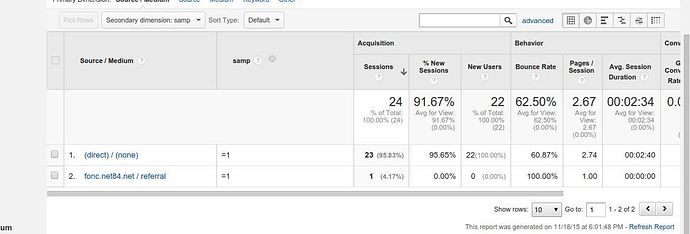Debunking the 'Secondary Dimension' in Google Analytics: Trick Insights
Debunking the 'Secondary Dimension' in Google Analytics: Trick Insights
Blog Article
Browsing the Depths of Second Dimension in Google Analytics: A Detailed Expedition on Its Capability
Secondary measurements, though seemingly simple at initial look, harbor a wealth of untapped possible waiting to be utilized. As we begin on this trip to check out the nuanced performance of second measurements, we will certainly discover just how this feature can light up patterns, introduce relationships, and ultimately pave the means for notified decision-making in the electronic landscape (what is a “secondary dimension” in google analytics?).
Understanding Additional Measurements in Google Analytics
Recognizing how second dimensions job is critical for leveraging the complete power of Google Analytics. By integrating primary metrics with secondary measurements, you can acquire important insights that drive notified decision-making and optimization techniques.
Leveraging Additional Dimensions for Information Analysis
Building upon the foundational understanding of how secondary dimensions boost data analysis in Google Analytics, the use of these added layers of information ends up being vital in drawing out useful insights for educated decision-making and optimization approaches. By leveraging secondary dimensions, analysts can dive much deeper right into the efficiency metrics by adding more context to the key measurements, thus discovering covert patterns and relationships that might not appear initially glimpse. This deeper degree of evaluation allows businesses to better comprehend individual actions, identify fads, and determine areas for renovation.
Furthermore, additional dimensions provide a more comprehensive view of the data, enabling for segmentation based upon different parameters such as demographics, devices, web traffic sources, and extra. This division assists in a more granular analysis, enabling organizations to customize their projects and approaches to details target market sectors for enhanced targeting and personalization. Essentially, the calculated use additional measurements equips organizations to make data-driven decisions that drive development and success in the electronic landscape.
Advanced Strategies for Additional Dimension Implementation
Checking out complex methods to harness the full possibility of additional measurements in Google Analytics raises the deepness and elegance of information analysis for critical decision-making. One sophisticated method for implementing additional measurements is making use of custom-made dimensions. By defining customized dimensions, individuals can sector information even more to obtain more details understandings right into customer behavior, such as tracking communications with certain components on a page or checking the performance of a certain marketing project. One more sophisticated approach is the utilization of regex (normal expressions) within additional dimensions. Regex enables even more flexible and powerful pattern matching, making it possible for individuals to produce complicated filters for data analysis. Furthermore, integrating second measurements with advanced sectors can give a lot more granular insights by applying several layers of division to the data. This approach enables for a much deeper understanding of customer habits based on numerous requirements at the same time. Executing these advanced strategies for additional dimensions in Google Analytics empowers customers to perform extra innovative evaluation and make data-driven decisions with precision.
Interpreting Insights With Secondary Dimensions

When analyzing understandings with second dimensions, it is important to take into consideration the context of the data and just how various dimensions communicate with each other. As an example, understanding which particular traffic resources cause greater conversion rates or identifying which gadgets users choose for making acquisitions can provide workable insights for maximizing marketing campaigns and enhancing total web site efficiency. By carefully taking a look at the information with second dimensions in mind, businesses can make educated decisions that drive significant results and improve their electronic existence.
Optimizing Efficiency With Secondary Dimensions

One key method to enhance performance with secondary measurements is by segmenting data much more granularly. This permits you to isolate details aspects that may be influencing your metrics and obtain a much better understanding of what drives success or failure in your electronic efforts. By integrating additional measurements such as 'device group' and 'touchdown web page,' you can determine which device types are most efficient for certain landing web pages, enabling you to tailor your methods appropriately.
Moreover, using secondary measurements can help you a fantastic read determine fads, patterns, and connections that might not be apparent when examining information with main dimensions alone. This deeper level of evaluation can lead to even more enlightened decision-making and ultimately boost the overall performance of your internet site or digital advertising projects.
Conclusion
Finally, second measurements in Google Analytics play a crucial function in boosting data evaluation and providing deeper insights right into site efficiency. By making use of innovative strategies and translating the data efficiently, companies can enhance their methods and enhance overall performance. Comprehending the performance of secondary dimensions is crucial for making informed choices and driving success in the digital landscape.
By leveraging additional dimensions, experts can dive much deeper into the efficiency metrics by adding more context to the primary dimensions, thus discovering surprise patterns and connections that could not be obvious at first glimpse. One innovative strategy for implementing secondary measurements is the use of custom-made measurements.Having understood innovative strategies like custom-made dimensions and regex for additional measurement application in right here Google Analytics, the next critical action is analyzing the important understandings acquired through these sophisticated data division techniques. Translating understandings with secondary dimensions entails assessing the partnerships between the second and key measurements selected, revealing patterns, fads, and read the article correlations that might not be quickly obvious when looking at the data in its whole.When translating insights through secondary dimensions, it is necessary to think about the context of the information and just how different measurements interact with each other.
Report this page